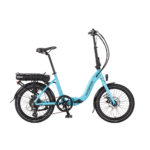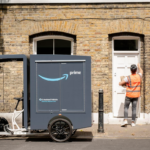affordable-15-ah-battery
As you probably know the Headway’s have a LiFePO4 cell chemistry, with a nominal cell voltage of 3.2V. For a 36v battery you need 12 cells in series to give a pack voltage of 38.4V. The charging voltage for a 12S battery is 43.8V. I have seen accounts that the cell voltage can be increased up to 4.0V with no apparent cell damage occurring. But that is not recommended by the manufacturers Headway. Personally I have found that taking the voltage much above 3.8v per cell is a waste of time, as the cells only accept a few more mA of charge above 3.65V. And I have noticed that cells that have been over voltage in the past seem to have a higher self discharge rate.
The type of charger used for LiFePO4 batteries should be a Constant Current/ Constant Voltage cc/cv.
Headway 38120S (10AH) cells have:-
For accessibility to individual cells I have made up the battery in 2 * 6S packs with balance leads and output leads attached to the cells. In use the 2 packs are connected in series 12S.
[url]http://farm5.staticflickr.com/4127/5396922866_565b4c4690_z.jpg[/URL]
With screw terminals instead of a welded or soldered tab connection, if a cell does go bad in the future, it is much easier to replace the bad cell. And as long as the new replacement cell is charged to the same state as the rest of the pack prior to putting the cell in the battery there should be no problems with balance.
Here are a couple of pictures showing my bulk charging setup using variable DC power supply with adjustable current limit (digimess SM5020).
[url]http://farm8.staticflickr.com/7206/7116571049_0f30f2fd75_z.jpg[/URL]
[url]http://farm8.staticflickr.com/7240/6970498638_f388d376ef_z.jpg[/URL]
There are a few videos on Youtube showing bulk charging some A123 cells with a similar power supply to mine.
[url=http://www.youtube.com/watch?v=o1TUAlvUliw&feature=related]Charging 12s2p A123 with Mastech Part 2 of 2 - YouTube[/URL]
I can charge the Headway as a 12S pack @ 43.8v up to 20A, but I generally charge at 10A or less which I think is kinder on the cells. I do have a 12S balancer which allows the batteries to be balanced as they are being charged @ up to 10A, or passively without the power supply. I can also use a cheap standard 5A 43.8V charger like this one from BMSBattery as the power source.
The other method of balance charging is to use one of the RC balance charges, with possible more accurate cell end point monitoring. I have a couple of iCharger 106B+, which are 6S 10A chargers along with 13.8v power supplies. You can parallel the two 6S packs of cells and balance charge as well. As these RC balance charges are powered from external power source, they can be used if you are away from a mains supply by using a 12v car battery. You must be careful not to flatten the car battery if you charge like this, as with over 250W load you can soon discharge the car battery.
[url]http://farm9.staticflickr.com/8161/6970504270_333b9cef44_z.jpg[/URL]
As regards LVC you can monitor at cell level using something like the celllog 8S M or the Chargery BM6 which can be set to give an audible alarm if an LV problem occurs. I don’t generally worry about LVC for the battery as the BLDC controllers have LV cut-off set around 31.5v for a 36v controller.
This is the celllog 8S which can record and store data a bit more expensive than the 8M.
[url]http://farm8.staticflickr.com/7072/7116578431_df4fa8cce5_z.jpg[/URL]
I have recently got one of the Speedict devices which are similar in use to the well known Cycle Analyst and can monitor and record all the parameters of the battery while in use, including Ah used, battery voltage etc, as well as speed and journey time. Which mean they act like a battery fuel gauge. But other simpler power meters are possible, like the Watts up or Turnigy Watt Meter and Power Analyzer.
Here is a picture comparison of 12S1P Headway 10Ah and 12S1P A123 2.3Ah packs.
http://farm8.staticflickr.com/7040/6970492944_736eb46219_z.jpg
Weight comparison of the batteries shown
Here is my homemade frame bag
http://farm8.staticflickr.com/7047/6970489780_d609020f2b_z.jpg
Chris
I know you will say it’s a lot easier to fit a BMS to the battery but I have had reliability problems in the past. May be it is possible, that some of the newer versions of BMS available now, mean that it could be worth a look again at a permanently attached BMS board. But in the meantime I use my tried and tested manual methods as described here.I've read about BMS's being less than reliable and consequently damaging cells. So with a BMS-less pack, say, 2X6s 10AH Headways, what would you need? How would you separate/connect the two packs for charging etc?
Need a LiFePO4-compatible RC Balance Charger that can cope with 6 cells plus Power Supply so you can charge to 3.6V each? How do you actually physically charge them? Photos would be good!
Then how do you ensure they don't get drained too low in use? A Volt &/or AH monitor obviously but is there some kind of simple pack LVC shut-off device or perhaps an alarm? (I think I've seen something on RC sites....)
If it came to replacing a cell would a new one cause problems in balancing even if charged to the same level as the others?
As you probably know the Headway’s have a LiFePO4 cell chemistry, with a nominal cell voltage of 3.2V. For a 36v battery you need 12 cells in series to give a pack voltage of 38.4V. The charging voltage for a 12S battery is 43.8V. I have seen accounts that the cell voltage can be increased up to 4.0V with no apparent cell damage occurring. But that is not recommended by the manufacturers Headway. Personally I have found that taking the voltage much above 3.8v per cell is a waste of time, as the cells only accept a few more mA of charge above 3.65V. And I have noticed that cells that have been over voltage in the past seem to have a higher self discharge rate.
The type of charger used for LiFePO4 batteries should be a Constant Current/ Constant Voltage cc/cv.
Headway 38120S (10AH) cells have:-
- Internal Impedance of <6mΩ
- Maximum Charge Current 2C(20A)
- Maximum Continuous Discharge Current 3C(30A)
- Maximum Peak Pulse Discharge Current 10C(100A)
- Minimum Discharge Voltage 2.0V
For accessibility to individual cells I have made up the battery in 2 * 6S packs with balance leads and output leads attached to the cells. In use the 2 packs are connected in series 12S.
[url]http://farm5.staticflickr.com/4127/5396922866_565b4c4690_z.jpg[/URL]
With screw terminals instead of a welded or soldered tab connection, if a cell does go bad in the future, it is much easier to replace the bad cell. And as long as the new replacement cell is charged to the same state as the rest of the pack prior to putting the cell in the battery there should be no problems with balance.
Here are a couple of pictures showing my bulk charging setup using variable DC power supply with adjustable current limit (digimess SM5020).
[url]http://farm8.staticflickr.com/7206/7116571049_0f30f2fd75_z.jpg[/URL]
[url]http://farm8.staticflickr.com/7240/6970498638_f388d376ef_z.jpg[/URL]
There are a few videos on Youtube showing bulk charging some A123 cells with a similar power supply to mine.
[url=http://www.youtube.com/watch?v=o1TUAlvUliw&feature=related]Charging 12s2p A123 with Mastech Part 2 of 2 - YouTube[/URL]
I can charge the Headway as a 12S pack @ 43.8v up to 20A, but I generally charge at 10A or less which I think is kinder on the cells. I do have a 12S balancer which allows the batteries to be balanced as they are being charged @ up to 10A, or passively without the power supply. I can also use a cheap standard 5A 43.8V charger like this one from BMSBattery as the power source.
The other method of balance charging is to use one of the RC balance charges, with possible more accurate cell end point monitoring. I have a couple of iCharger 106B+, which are 6S 10A chargers along with 13.8v power supplies. You can parallel the two 6S packs of cells and balance charge as well. As these RC balance charges are powered from external power source, they can be used if you are away from a mains supply by using a 12v car battery. You must be careful not to flatten the car battery if you charge like this, as with over 250W load you can soon discharge the car battery.
[url]http://farm9.staticflickr.com/8161/6970504270_333b9cef44_z.jpg[/URL]
As regards LVC you can monitor at cell level using something like the celllog 8S M or the Chargery BM6 which can be set to give an audible alarm if an LV problem occurs. I don’t generally worry about LVC for the battery as the BLDC controllers have LV cut-off set around 31.5v for a 36v controller.
This is the celllog 8S which can record and store data a bit more expensive than the 8M.
[url]http://farm8.staticflickr.com/7072/7116578431_df4fa8cce5_z.jpg[/URL]
I have recently got one of the Speedict devices which are similar in use to the well known Cycle Analyst and can monitor and record all the parameters of the battery while in use, including Ah used, battery voltage etc, as well as speed and journey time. Which mean they act like a battery fuel gauge. But other simpler power meters are possible, like the Watts up or Turnigy Watt Meter and Power Analyzer.
Here is a picture comparison of 12S1P Headway 10Ah and 12S1P A123 2.3Ah packs.
http://farm8.staticflickr.com/7040/6970492944_736eb46219_z.jpg
Weight comparison of the batteries shown
- Headway 12S 4.34Kg
- A123 26650 12S 940g
Here is my homemade frame bag
http://farm8.staticflickr.com/7047/6970489780_d609020f2b_z.jpg
Chris
Last edited:







